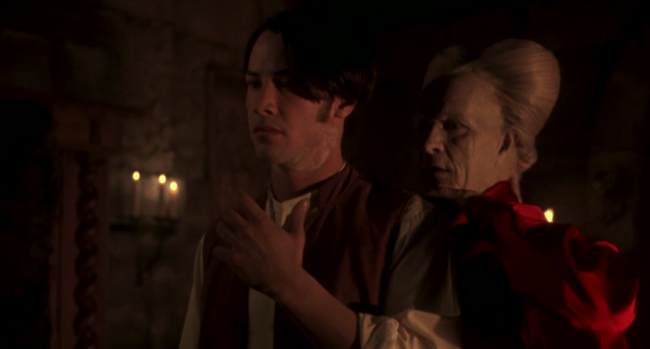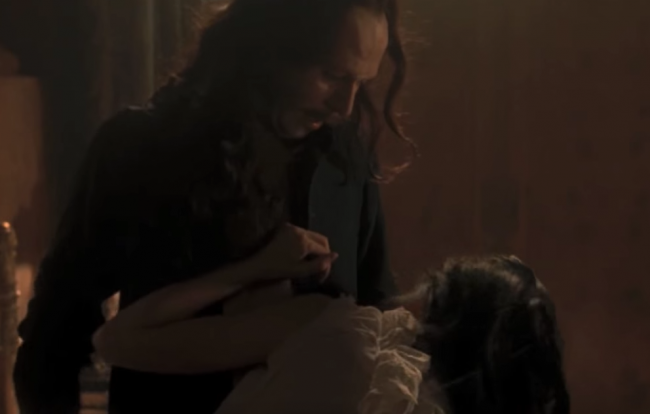That Moment In ‘Bram Stoker’s Dracula’ (1992): Turning Mina
A closer look at a crucial moment in this classic horror film.

Bram Stoker’s Dracula is a 1992 horror film following the origin story of the famous first vampire. A visionary masterpiece, it was hailed by critics for its production but faulted for some of its casting. A modest box office hit, it has become a cult favorite.
The tragedy of the Dracula story is of course the love story behind it. Bram Stoker’s Dracula paints this tale with some beautifully impressive visual effects that are so well made, most believe they are computer-generated. These effects help illustrate the strange and ethereal feel of the complex story, giving the film its fantastical tone and helping to create a fable-like atmosphere. If there is one strength that makes this film so memorable, it is how it looks.
Directed by Francis Ford Coppola, Bram Stoker’s Dracula is essentially a horror film but is not marked by the standard tropes of that genre, instead feeling more like a tormented love story with lots of toothy bloodletting, as surely intended, as Dracula (Gary Oldman) denounces God and his faith after his beloved Elisabeta (Winona Ryder) commits suicide after falsely being told of her lover’s death in battle, knowing she is condemned to damnation. Dooming himself, he spends eternity demonically cursed in darkness until hundred of years later, he believes Elisabeta has been reincarnated as Mina, the fiancée of Jonathan Harker (Keanu Reeves), his latest financial solicitor. Now he must earn her love again.

While most point to Reeves as the larger failing of the film, his poor performance and acting style far removed from those in the rest of the cast, Coppola defends the choice purely for business reasons. The young handsome heart-throb brought young people to the cinema. It is true that Reeves does lessen the experience, his surfer dude persona at the time staining what should be a more dramatic tone, but it’s not enough to ruin the film entire. Oldman and Ryder are sensational, and Coppola’s direction some of the best in his career. And like every movie, it has one great moment.
Turning Mina
Dracula has charmed the lovely Mina but not enough that she has changed her mind about marrying Jonathan, which enrages the vampire. He has been on a rampage, killing some and changing others. When he visits Mina alone in the bedroom of a friend she has taken refuge in, she confesses that she does remember her former life as Dracula’s Elisabeta and is falling in love with him again. She desires for him to become the vampire, to show her who he truly is. Overcome by the horrors of the world outside caused by Dracula’s love for her, she can’t deny the ancient pangs in her heart for him and desires to be like him.

He sinks his teeth into her neck to taste her blood, and she pleads with him to turn her so she might live her life with him, desperately begging him to take her away from all this death. Hopelessly unarmored, he opens a vein in his chest and invites her to drink from him and join his curse, but as she does, weeping, he pulls her away, unable to let her be condemned to the demons like him. But she insists and suckles upon the blood as he revels in the completion of centuries-old quest. The turning has begun.

It’s about sex. This powerfully erotic moment, a sequence layered in blood and horror, represents a sexual encounter, most notably, fellatio. Both characters fall into an inescapable lust for the other and Coppola uses their bodies and camera angles to simulate and metaphorically replicate the act of physical love, with Dracula receiving intense satisfaction from Mina’s attention. Every movement, every image, and every word is driven by this notion, something the Dracula lore has long kept as part of its underlying themes.

But equally effective is the emotional release as Dracula is heart-breakingly torn, finally finding his lost love and given the chance to bring her home but at the cost of damning her to the demons for an eternity. What’s important in this exchange is how he actually stops her from continuing, crushed by the prospect of her fate, loving her too much to carry her into the darkness with him, yet it is Mina that makes that choice and readily drinks his flowing blood. She comes to him. It’s a great moment.
